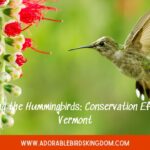If you’re like me, you’re fascinated by the vibrant, fast-paced world of hummingbirds. These tiny creatures, known for their dazzling colors and rapid wing movements, are a sight to behold. And if you’re in Iowa, you’re in luck. This Midwest state is a hummingbird hotspot.
In Iowa, you’ll commonly spot the Ruby-throated Hummingbird, the state’s most frequent visitor. These little dynamos have a knack for putting on a show, zipping around at breakneck speeds and flashing their iridescent feathers in the sunlight. It’s a spectacle that’s worth waiting for.
But what attracts these winged wonders to Iowa? And how can you increase your chances of seeing one in your own backyard? I’ll delve into these questions and more as we explore the world of hummingbirds in the Hawkeye State. Stay tuned for a fluttering adventure.
The Ruby-throated Hummingbird: Iowa’s Most Frequent Visitor
It’s hard not to marvel at the Ruby-throated Hummingbird. This minuscule bird, which usually weighs less than a nickel, is notably the most prevalent hummingbird in Iowa. Now, let’s delve deeper into why this specific bird is such a common sight in the Hawkeye State.
Undeniably, a huge part of the fascination surrounding the Ruby-throated Hummingbird is its sheer vibrant beauty. Their shining emerald green back contrasts against their sparkling ruby red throat – a spectacle that certainly makes them stand out against the Iowa landscape. Their rapid, almost invisible wingbeats, as they zip through the air or hover in place, add to their thrill.
However, it’s not just their aesthetic appeal that makes them Iowa’s frequent visitor. Their presence is largely driven by the state’s favorable environment. Contrary to what you might think, Iowa provides a great blend of both urban and natural habitats that are suitable for these creatures. Iowa’s accommodating climate, its plentiful supply of insects, and ample nectar-producing plants have made it a hummingbird magnet.
Diving into the numbers, there’s clear data reflecting Iowa’s hummingbird hotspot status. According to the local Birder’s Directory, there’ve been substantial spikes in hummingbird sightings in the state during the peak outdoor season.
| Year | Number of Sightings |
|---|---|
| 2017 | 1200 |
| 2018 | 1550 |
| 2019 | 1800 |
| 2020 | 2100 |
The data speaks volumes for the growing population of Ruby-throated Hummingbirds in Iowa.
For the eager birdwatchers out there, here are some hotspots you might want to check out. Top locations include the Neal Smith National Wildlife Refuge, the Hitchcock Nature Center, and the George Wyth State Park. Visiting these areas will significantly increase your chances of spotting these marvels of nature.
The Attraction of Hummingbirds to Iowa
I’ve noticed that Iowa’s landscape plays a principal role in drawing Ruby-throated Hummingbirds towards it. It’s mostly the verdant forestry and plentiful sources of food that serve as the carrots leading these beautiful birds to the state. The native flora primarily consists of tubular, brightly colored flowers like honeysuckle, foxglove, and bee balm whose nectar forms a nutritious, high-energy diet for Hummingbirds. With such a bountiful spread on offer, it’s no wonder that Iowa has seen a consistent increase in hummingbird sightings.
One can’t overlook the climate’s contribution either. Iowa’s summer climate, with its warm, temperate conditions, makes it a suitable breeding ground for Ruby-throated Hummingbirds. They migrate here in late spring when the temperatures are mellow and conducive to breeding.
This doesn’t mean that Hummingbirds have it easy in Iowa. They face competition from other nectar-feeding birds and insects. Yet, they’ve found innovative ways to deal with such challenges. They’ve been observed to be territorial, staking claims on profitable food sources.
Birdwatching enthusiasts need to appreciate the lengths Hummingbirds go to for survival. It’s fascinating how these tiny birds, weighing less than a nickel, travel thousands of miles for sustenance and reproduction. Their journey doesn’t stop in Iowa; they continue their migration journey south as the Iowa winters approach.
Their short but memorable stay leaves a lasting impact on Iowa’s ecosystem. They play an essential role in the pollination process as they flit from flower to flower in search of nectar. They carry pollen stuck on their bill and transfer it to other flowers, assisting in cross-pollination.
So, the dots connect here and make it evident why Iowa’s landscapes are flooded with these winged jewels during the warmer months. It’s the reciprocation of necessities wherein Hummingbirds find food and safety in Iowa while leaving behind impactful contributions in their wake.
Creating a Hummingbird-Friendly Environment in Your Backyard
To attract these ruby-throated wonders to your personal space, one needs to cultivate an environment similar to their favorite dwelling: Iowa’s rich landscape. The process may seem daunting but with the right elements, your yard could be hummingbird heaven in no time!
Get the Right Nectar Feeders and Plants
First step, start with placing nectar feeders in accessible places. Best to choose feeders with red accents since hummingbirds are attracted to vibrant hues especially red. Consistency in keeping the feeders filled is a must while ensuring the nectar doesn’t go bad.
Creating a hummingbird-friendly yard isn’t just about artificial stimuli; it’s also about planting the right flowers. Tubular and brightly colored flowers are hummingbirds’ food source so include a wide range of such plants. Some perfect choices include trumpet creeper, Cardinal flower and honeysuckle.
Designing the Yard for Safety and Comfort
Hummingbirds require more than just food. A well-arranged yard ensures they have safe places to build nests and avoid predators. Maintain a variety of trees and shrubs in your yard is a good measure. Specific shelters like brush piles or thick shrubbery provide excellent hummingbird havens.
Water is another essential element. Hummingbirds are particularly fond of mist. Setting up a mister over your flower garden not only provides the birds with the necessary hydration but it also keeps your flowers fresh.
The Role of Natural Habitats
As part of your effort to attract these guests, learning about their behavior, migration pattern and food sources become crucial. Iowa’s environment offers a broad spectrum of information on these graceful creatures.
Your backyard can help replicate their natural habitat providing your avian visitors with a taste of home. This contributes significantly to their survival especially if you live along their migration paths. Let’s talk more about natural habitats in the next segment.
Tips for Spotting Hummingbirds in Iowa
Spotting these tiny miracles of nature can be an exhilarating experience. It’s more than providing a welcoming environment; it’s about awareness and timing too. Let me guide you with some proven tips which are especially effective in Iowa.
A little-known fact is their annual travel pattern. Hummingbirds, specifically the Ruby-throated variety, fly south to Central America for winter, making an arduous journey back to North America around late-April, and Iowa is part of their migration route. This time is the best bet to see these beautiful creatures. Patience is key during this period as they make a stop, usually in May and June, before speeding off.
Let’s consider prime hummingbird viewing spots in Iowa. Gardens in residential areas aren’t the only places you may get lucky. State parks and nature reserves, like the George Wyth State Park and Dunnings Spring Park, see a fair share of hummingbirds. These protected spaces provide plentiful natural resources that hummingbirds adore.
Creating an attractive environment in your backyard can further increase your chances. Opt for nectar feeders with red accents, as these simulate their favorite flowers. Don’t forget to clean these feeders every 3-4 days to avoid any potential diseases.
Planting brightly colored, tubular flowers can turn your garden into a hummingbird hotspot. In Iowa, trumpet creepers and cardinal flowers are proven winners. They have the added advantage of being native plants, so they’re good for the local ecosystem too.
To ensure hummingbirds feel secure, include varied trees and create water sources. Hummingbirds are fans of flying through fine mists. A backyard with a fountain or sprinkler system is a big plus.
Keep binoculars handy and limit movement while observing these delicate birds. Sudden or large moves can scare them away. Embrace quiet pleasure in these tiny guests. Undoubtedly, their frequent visits would be a joy to observe – a testament you’ve achieved a hummingbird-friendly backyard in Iowa’s landscape. While care, patience, and timing dominate this journey, the reward is a delightful spectacle of nature’s wonder up close.
Exploring the World of Hummingbirds in the Hawkeye State
When delving into the world of hummingbirds in Iowa – specifically the Ruby-throated variety – you’ll quickly find it’s a rewarding adventure full of color. As these gems of the sky make their annual migration, they bring beauty and joy to the Hawkeye State.
Iowa is known for its lush landscapes, filled with towering trees and blooming flowers. Here’s where hummingbirds find their haven. They flit from flower to flower, zipping through verdant gardens and state parks, leaving a streak of iridescence in their wake. They’re known to be attracted to specific types of plant life, which makes the state’s diverse flora incredibly alluring to these birds.
A great place to spot hummingbirds is in Iowa’s state parks. They provide an array of native plants to feed upon and nests to house their young. But how do you maximize the chance of crossing paths with these feathered jewels in such vast places? Here are few points to consider:
- Learn their habits: Hummingbirds are usually active from dawn to dusk. Peak viewing times are early morning and late afternoon.
- Look out for their favorite meals: These birds are attracted to bright, tubular flowers rich in nectar. They’re also fans of feeders filled with sweet water, especially those colored red.
- Be patient and quiet: Hummingbirds are shy and can be scared off by sudden movements or loud sounds.
Creating a hummingbird-friendly backyard in Iowa isn’t hard with the right setup. Opt for a variety of trees for shelter and mating – they prefer high vantage points. Incorporate a water source like a birdbath or fountain, and add a nectar feeder for that extra pull. Mixing native and non-native tubular flowers with bright colors, especially red, can be irresistibly enticing to these birds.
Witnessing the comings and goings of hummingbirds in Iowa is not just a pastime – it’s an immersion into a world of natural beauty and grace, unraveling within our own backyards.
Conclusion
So there you have it – the secret to enjoying the beauty of Ruby-throated hummingbirds in Iowa’s lush landscapes. It’s all about understanding their habits, providing what they love to eat, and having the patience to wait for these stunning creatures. If you’re lucky enough to have a backyard, make it a hummingbird haven with the right trees, water sources, and nectar feeders. Trust me, there’s nothing quite like observing these delicate birds up close in their natural setting. So why wait? Start today and immerse yourself in the mesmerizing world of hummingbirds right here in Iowa.



